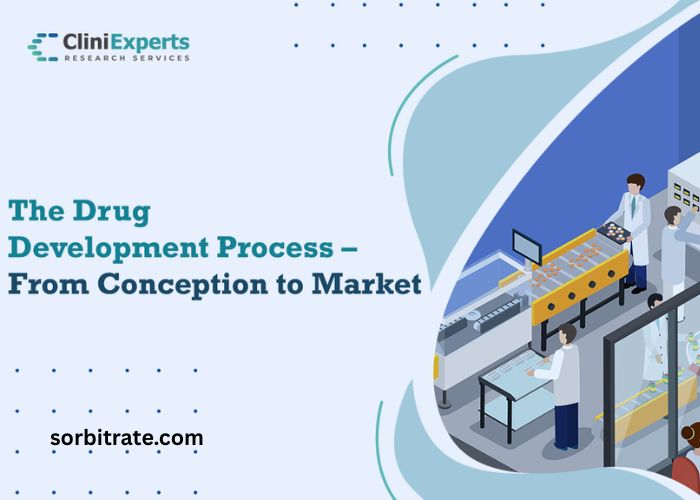The drug development process is a complex, lengthy, and costly journey that transforms scientific discoveries into safe and effective medicines. Every new drug on the market has undergone rigorous testing and evaluation to ensure it can treat diseases effectively without causing undue harm.
Understanding the drug development process is essential not only for healthcare professionals and researchers but also for patients and the general public. It reveals the incredible scientific, regulatory, and ethical efforts behind every prescription or over-the-counter medication.
In this article, we’ll explore each phase of the drug development process — from discovery, preclinical testing, and clinical trials to regulatory approval and post-market surveillance — shedding light on how medicines reach you.
What is the Drug Development Process?
The drug development process refers to the series of steps scientists and pharmaceutical companies follow to discover, test, and bring new drugs to market. It is designed to ensure that new medications are safe, effective, and high quality.
This process can take anywhere from 10 to 15 years or more and typically costs billions of dollars. Despite the long timeline and high failure rate, it remains essential for advancing medicine and improving public health.
Step 1: Drug Discovery
The journey begins with drug discovery, a research phase focused on identifying potential compounds that can affect a disease or condition. Scientists study the biological mechanisms of diseases to identify specific targets, such as proteins or enzymes, which can be modulated by a drug.
During drug discovery:
-
Researchers use techniques like high-throughput screening to test thousands of compounds.
-
Computer modeling and artificial intelligence help predict how molecules might interact with targets.
-
Promising compounds, called lead compounds, are modified and optimized for potency and safety.
The goal is to find a molecule that can effectively treat the disease with minimal side effects.
Step 2: Preclinical Testing
Before testing in humans, candidate drugs undergo preclinical testing to evaluate their safety and biological activity. This phase involves:
-
Laboratory experiments using cell cultures.
-
Animal studies to assess toxicity, pharmacokinetics (how the drug moves through the body), and pharmacodynamics (how it affects the body).
Preclinical testing aims to identify any harmful effects and establish safe dosage ranges. Only drugs that pass these tests proceed to clinical trials.
Step 3: Clinical Trials
Clinical trials are research studies conducted on human volunteers to assess a drug’s safety and efficacy. They are divided into three main phases plus a post-marketing phase:
Phase I – Safety and Dosage
-
Conducted on 20 to 100 healthy volunteers or sometimes patients.
-
Focuses on determining safe dosage ranges and identifying side effects.
-
Assesses how the drug is absorbed, metabolized, and eliminated.
Phase II – Efficacy and Side Effects
-
Involves several hundred patients with the target condition.
-
Tests whether the drug is effective and further evaluates safety.
-
Determines optimal doses and monitors short-term side effects.
Phase III – Confirmation and Comparison
-
Large-scale trials involving thousands of patients.
-
Confirms effectiveness and monitors adverse reactions.
-
Compares the new drug to existing treatments or placebos.
-
Data collected in Phase III is critical for regulatory approval.
Step 4: Regulatory Review and Approval
Once clinical trials demonstrate a drug’s safety and effectiveness, pharmaceutical companies submit a New Drug Application (NDA) or Biologics License Application (BLA) to regulatory agencies such as the FDA (U.S. Food and Drug Administration) or EMA (European Medicines Agency).
The agency reviews all data from preclinical and clinical testing to evaluate:
-
Drug safety and efficacy.
-
Manufacturing quality and consistency.
-
Labeling and usage instructions.
If the drug meets standards, it receives approval for marketing and sale. The review process can take months to years depending on the drug and urgency.
Step 5: Post-Marketing Surveillance (Phase IV)
After approval, the drug enters the market but continues to be monitored through post-marketing surveillance to:
-
Detect any rare or long-term side effects.
-
Evaluate real-world effectiveness.
-
Ensure ongoing safety.
Regulatory bodies and pharmaceutical companies collect data from healthcare providers and patients to respond to any emerging concerns.
Challenges in the Drug Development Process
The drug development process is fraught with challenges:
-
High Costs: Developing one successful drug can cost over $2 billion.
-
Long Timeframes: On average, the process can take 10 to 15 years.
-
High Failure Rate: Over 90% of drug candidates fail during clinical trials.
-
Regulatory Complexities: Strict guidelines ensure safety but require significant documentation and compliance.
-
Scientific Uncertainty: Understanding complex diseases and how drugs interact with the body is difficult.
Despite these hurdles, ongoing innovation aims to streamline and improve the process.
Innovations Accelerating Drug Development
New technologies are transforming how drugs are developed:
-
Artificial Intelligence (AI): AI speeds up drug discovery by analyzing biological data and predicting drug-target interactions.
-
Biomarkers: Molecular indicators help identify the right patients for clinical trials and monitor responses.
-
Adaptive Clinical Trials: Flexible designs allow modifications based on interim results, reducing costs and time.
-
Personalized Medicine: Tailoring treatments to genetic profiles enhances efficacy and safety.
-
Gene and Cell Therapies: New modalities targeting the root causes of diseases rather than symptoms.
These advances hold promise to bring safer, more effective drugs to patients faster.
Importance of Patient Participation
Patients play a vital role in clinical trials by volunteering to test new treatments. Their participation:
-
Enables scientific evaluation of new drugs.
-
Helps identify benefits and risks.
-
Drives progress in medicine.
Awareness and education about clinical trials can improve recruitment and help bring new therapies to market.
Conclusion
The drug development process is a rigorous and multi-faceted journey vital to advancing healthcare. From the earliest discovery of potential compounds to extensive testing in clinical trials and regulatory review, each step ensures that new medicines are safe and effective.
While time-consuming and expensive, the process protects patients and improves health outcomes globally. With continuous innovation and collaboration, the future of drug development looks promising—offering hope for treating complex diseases and improving lives worldwide.

